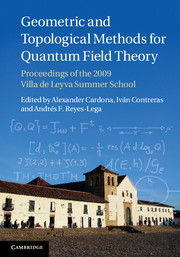 Geometric and Topological Methods for Quantum Field Theory
Geometric and Topological Methods for Quantum Field Theory Published online by Cambridge University Press: 05 May 2013
Abstract
These lecture notes are based on a series of lectures given at the school on “Geometric and Topological Methods for Quantum Field Theory”, in Villa de Leyva, Colombia. We present a basic introduction to Dirac manifolds, recalling the original context in which they were defined, their main features, and briefly mentioning more recent developments.
Introduction
Phase spaces of classical mechanical systems are commonly modeled by symplectic manifolds. It often happens that the dynamics governing the system's evolution are constrained to particular submanifolds of the phase space, e.g. level sets of conserved quantities (typically associated with symmetries of the system, such as momentum maps), or submanifolds resulting from constraints in the possible configurations of the system, etc. Any submanifold C of a symplectic manifold M inherits a presymplectic form (i.e. a closed 2-form, possibly degenerate), given by the pullback of the ambient symplectic form to C. It may be desirable to treat C in its own right, which makes presymplectic geometry the natural arena for the study of constrained systems; see e.g. [23, 25].
In many situations, however, phase spaces are modeled by more general objects: Poisson manifolds (see e.g. [35]). A Poisson structure on a manifold M is a bivector field π ϵ Γ(Λ2TM) such that the skew-symmetric bracket {f, g} ≔ π(df, dg) on C∞(M) satisfies the Jacobi identity. Just as for symplectic phase spaces, there are natural examples of systems on Poisson phase spaces which are constrained to submanifolds. The present notes address the following motivating questions: what kind of geometric structure is inherited by a submanifold C of a Poisson manifold M?
To save this book to your Kindle, first ensure [email protected] is added to your Approved Personal Document E-mail List under your Personal Document Settings on the Manage Your Content and Devices page of your Amazon account. Then enter the ‘name’ part of your Kindle email address below. Find out more about saving to your Kindle.
Note you can select to save to either the @free.kindle.com or @kindle.com variations. ‘@free.kindle.com’ emails are free but can only be saved to your device when it is connected to wi-fi. ‘@kindle.com’ emails can be delivered even when you are not connected to wi-fi, but note that service fees apply.
Find out more about the Kindle Personal Document Service.
To save content items to your account, please confirm that you agree to abide by our usage policies. If this is the first time you use this feature, you will be asked to authorise Cambridge Core to connect with your account. Find out more about saving content to Dropbox.
To save content items to your account, please confirm that you agree to abide by our usage policies. If this is the first time you use this feature, you will be asked to authorise Cambridge Core to connect with your account. Find out more about saving content to Google Drive.